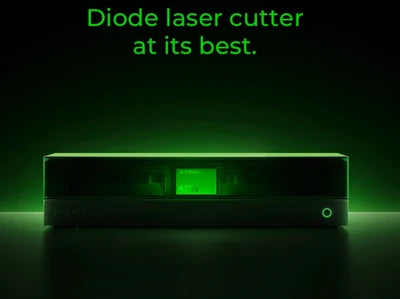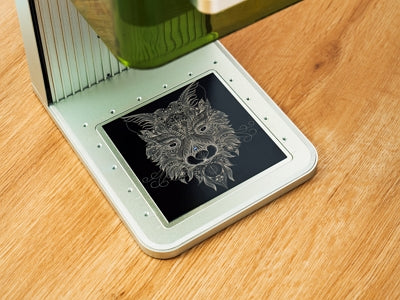CNC Engraving vs Laser Engraving: Discover the Difference
When deciding which type of engraving to use for a certain project, it's important to understand the differences between CNC and laser engraving. While both processes involve engraving a design onto a material, some key differences exist in how they are achieved and the results they produce.
In this article, we'll explore what CNC engraving and laser engraving are, their main differences, their advantages and disadvantages, and the best way to decide which one is best for your project.
In This Article
- What is CNC Engraving?
- What is Laser Engraving?
- CNC Engraving vs Laser Engraving: The Main Differences
- Advantages and Disadvantages of CNC Engraving and Laser Engraving
- Conclusion
What is CNC Engraving?
CNC engraving is a process of creating intricate designs and shapes on a surface through the use of a CNC (computer numerical control) machine. It's a subtractive process where the machine uses rotating cutters, or burrs, to cut away material to create the desired shape.
CNC engravings are of two types:
1) CNC milling engraving
CNC milling machines are used as CNC engraving machines but they require a high speed of spindle due to the small size of the tool and the hardness of the material.
CNC milling engraving is used when our base material to engrave is stainless steel, mild steel, aluminum, brass, wood, plastics, and some other materials as well. In a CNC milling engraving machine, the work piece is held in between the fixtures, and the tool moves in order to get the required engraving.
CNC milling engraving machines come in a variety of sizes based on the size of the bed. It depends on the user of the machine as to what size they need.
Let’s say if a mass production factory requires a CNC milling engraving machine they must be needing small machine because they are manufacturing some small items, similarly DIY industry needs a small machine. Various sizes can be checked on the CNC manufacturer’s website as per the requirements.
2) CNC router engraving
CNC router engraving and CNC milling machines have only one difference: in the case of router engraving, the router is hand-held and mounted on a motor. In CNC milling, the router is mounted on the machine head. It is a good option if you have printouts on the work piece.

Usually, router engravings are three-axis. CNC routers are used on softer materials such as wood, plastic, and acrylic because they are less robust than milling machines.
A CNC router has quite a few applications, like furniture making, signature making, cabinet making, art and craft, molds, and prototyping. While purchasing a router, always consider the type of drive system (rack and pinion, lead screw, and ball screw), motor (if it is servo or stepper), machine weight, and software used.
What is Laser Engraving?
Laser engraving is a versatile and precise method for etching designs into surfaces. It uses a focused beam of light to quickly and accurately create a design on various materials. From customizing jewelry, trophies, and awards to engraving signs and logos, laser engraving provides an efficient way to add an eye-catching, permanent design to almost any surface.
It's a non-contact process that uses a powerful laser beam to cut or etch a design into a material. Laser engraving is a popular method for creating intricate designs on metal, plastic, wood, and other materials. The light beam used in the process is highly concentrated and precise so that the design can be detailed and intricate.

The laser engraving machine is the main tool used in the process. It contains a computer-controlled laser module/head, the source of the focused light beam.
The laser engraving process is fairly straightforward. First, the material to be engraved is placed into the laser engraving machine. Then, the computer-controlled laser module traces the design onto the surface, burning away material from the surface to create the desired design.
In addition to its accuracy, laser engraving is a fast and economical way to add a personalized touch to items. It is also great to add branding or logos to business items, such as nameplates, awards, and trophies.
Laser engraving is a versatile and reliable method for adding a custom touch to almost any surface. Whether you're looking to personalize jewelry, engrave signs, or create intricate designs, laser engraving is an efficient and precise way to get the job done.
CNC Engraving vs Laser Engraving: The Main Differences
Whether you choose to use a CNC or a laser engraving machine, understanding the differences between these two methods is key to selecting the right engraving process for your project. With the right engraving method and machine, you can create stunning designs and intricate shapes on various materials.
1) Process
CNC engraving is a subtractive process that removes material from a surface to create the desired shape. It is typically done with a CNC (Computer Numerical Control) router machine, which uses a cutting tool to cut away material along predetermined paths to create the desired shape or design.
This method is often used to create intricate, detailed shapes and designs in various materials, including metals, plastics, and wood.
On the other hand, laser engraving is a non-contact process that uses a focused beam of light to etch a design onto a surface. Laser engraving machines use a computer-controlled laser beam to vaporize the material in a pattern that precisely replicates the programmed design.
This method is ideal for detailed engraving designs on various materials, including wood, metals, plastics, and glass, etc.
When deciding between CNC and laser engraving, it's important to consider a few factors. CNC engraving is better for larger projects where accuracy is more important, while laser engraving is usually better for smaller projects where intricate detail and accuracy are key.
Additionally, laser engraving is often more cost-effective than CNC engraving since the laser engraving machine requires less maintenance and can be used for a wider range of materials.
2) Accessories
CNC engraving machines are equipped with a range of accessories to keep the machine running efficiently and safely. Common accessories include diamond engraving bit holders, toggle clamps, carbide cutting tools, vises, machine housings, lubrication systems, cooling systems, collet holders, spindle-mounted dusters, and suction pumps.
These accessories help keep the work area clean by removing dust and debris with a spindle-mounted dust shoe and suction pump. They also help to keep the material and cutting tool cool by providing a liquid cooling system to prevent overheating.
Laser engraving machines require additional accessories to enable them to engrave on curved surfaces. These accessories include a rotary attachment, air assist system, exhaust system, and safety goggles. The rotary attachment provides an additional rotating axis, allowing the laser machine to engrave on cylindrical surfaces.
By using the right accessories, CNC and laser engraving machines can work safely and efficiently, making sure that your engraving projects are completed with precision and accuracy.
3) Design Phase
The main difference between CNC engraving and laser engraving is the type of file required during the design phase. CNC engraving requires a CAD file while laser engraving requires a vector or raster file.
4) Materials
CNC engraving is commonly employed on metals, wood, and some plastics, providing a high-precision output that can create unique items. Not only that, CNC engraving can be carried out on various materials such as aluminum, brass, and copper.
On the other hand, laser engraving is a more versatile option for a much wider range of materials. Wood, plastics, glass, anodized aluminum, and certain types of stone can all be engraved with a laser engraving machine. Laser engraving also offers higher levels of precision and detail than CNC, allowing for even more intricate designs.
The materials used in laser engraving can also be marked with high-contrasting colors and finishes, allowing the laser-engraved design to stand out even more. This process makes laser engraving ideal for creating customized gifts or promotional materials.
5) Precision
The accuracy of CNC machines can vary depending on the type of machine and the process used.
Standard CNC machines can provide an accuracy of about 0.001" to 0.005", which is suitable for most manufacturing applications. However, for processes that require very high accuracy, specialized processes like polishing can provide a repeatable accuracy of 0.00005".
Laser engravers are available in desktop and industrial-grade models. Generally, desktop laser engravers provide an accuracy of around 0.001", while industrial-grade laser machines can be accurate up to 0.00005".
The accuracy of laser engraving machines depends largely on the quality of the laser beams and the materials used. High-quality laser beams and specialized materials can help increase the accuracy of the laser engraving process.
Laser engraving machines can be the best option for applications requiring extreme accuracy. However, for most applications, standard CNC machines are the best choice. The accuracy of these machines is more than adequate for most manufacturing applications.
Advantages and Disadvantages of CNC Engraving and Laser Engraving
1) CNC Engraving
The advantages of CNC engraving include its high level of accuracy in cutting and its ability to work on a wide range of materials. It's also a relatively fast process, which can be a major advantage in some cases. On the other hand, CNC engraving can be expensive and requires a high level of expertise to operate the machine correctly.
2) Laser Engraving
The major advantages of laser engraving are its affordability, versatility, and relative ease of use. Laser engraving is also a non-contact process, making it much less likely to damage the engraved material.
Conclusion
It's important to understand the differences between CNC Engraving and laser engraving to choose the correct process for your project. Both methods have advantages and disadvantages, so it is crucial to consider all factors before making any decision. If you are still facing problems trying to decide which process to use, it may be worth seeking advice from an experienced engraver to ensure you get the best possible results.




